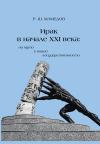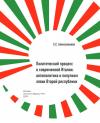Making Sense of Global Risks
Вход
Авторизуйтесь, если вы уже зарегистрированы
On January 8th 2013 the World Economic Forum released its eighth annual Global Risks Report. The Report is designed to analyze the perceived likelihood, impact and interconnections of 50 risks that have global consequences. These risks are divided into five major categories, and each of these categories has its center of gravity – the most important risk (indicated in parentheses):
- Economic (major systemic financial failure )
- Environmental (failure of climate change adaptation)
- Geopolitical (global governance failure)
- Societal (water supply crises)
- Technological (critical systems failure)
In 2013 the top risks by likelihood to occur in the next ten years and by impact if the risk were to occur include: severe income disparity, chronic fiscal imbalances, water supply crisis, rising greenhouse gas emission, mismanagement of population ageing, food shortage crisis, and diffusion of weapons of mass destruction.
According to the Report the risk that is most likely to manifest is severe income disparity (4.14 out of 5) and the risk that is to have the highest impact is major systemic financial failure (4.05 out of 5). The most disturbing are the risks that appear in the top five risks of both lists (likelihood and impact) – chronic fiscal imbalances and water supply crisis. As we can see the majority of top risks are in the economic and societal categories. The assessment of technological risks seems to be more optimistic as none of the risks in that category is among the top five by likelihood and impact, although in 2012 cyber attacks were assessed as an imminent threat.

The top risks might change over time. For example, since 2007 the risk that was identified as the most likely to occur changed from breakdown of critical information infrastructure to severe income disparity in 2013. And in terms of impact since 2007 the risks in economic category (from asset price collapse in 2007 to major systemic financial failure in 2013) were ranked first in top five.

Moreover, it is quite interesting to observe how assessments might vary depending on the background of respondents. For example, people working for NGOs tend to assign higher scores to risks than people working for government, and so on.
National resilience
Risks usually manifest at the national level, therefore it is particularly important to understand how countries respond to emerging challenges. And for the first time the Global Risk Report focuses on national resilience, which is counties’ ability to weather global risks. Can country adapt to changing new context? Can country withstand certain shocks in the face of each of the 50 risks? Can country recover from the crisis?
Methodology for assessment of national resilience is still being developed. So far, so far only two sets of scores constituting national resilience are available: Government’s Risk Adaptation Score and Government’s Risk Management Effectiveness Score.
As for Russia, its scores are quite average and rather similar to those of countries which are as well in transition from efficiency-driven to innovation driven stage of the economic development. Russia’s Risk Adaptation Score is 2.84 (out of 4) and its Government’s Risk Management Effectiveness Score is 3.6 (out of 7).
If we compare Russia’s Risk Adaptation Score to other BRICS nations, we can see that China and Brazil have better capability to adapt to global risks (3.26 and 3.01 respectively), while South Africa and India have lower scores (2.77 and 2.71). As for government’s effectiveness in managing risks, we can see that Russia’s capability to manage risks is much lower compared to the other BRICS nations: Russia is ranked 73rd, while China – 30th (right after the USA- 29th), South Africa – 34th, India - 38th, and Brazil - 45th.
Methodology and its criticism
The global risk assessment is based on an annual perception survey of over 1000 experts from industry, government, academia and civil society. For each of 50 risks experts are asked to assess on a scale from 1 to 5 its likelihood of occurring over the next ten years and its impact. Then the average likelihood and impact for each risk is calculated.
To identify interconnections between risks experts are asked to choose pairs of risks (min of 3 and max of 10) which they think are connected. Then all chosen connections are put together and presented in a diagram.
The methodology for the calculation of newly introduced national resilience is going to be more complex as the qualitative assessment will be coupled with quantitative data. As a first step towards measuring resilience, the following qualitative assessment was undertaken:
- over 14000 respondents (top managers from small and medium-sized firms) were asked to assess on a scale from 1 (not effective) to 7 (effective) their government’s effectiveness in managing risks in 2012
- over 1000 respondents to the Global Risks Perception Survey were asked to assess, per risk, on a scale from 1 to 4 their country of expertise’s ability to adapt and or recover from its impact.
The quantitative part of measuring national resilience is outlined in the report, and apparently will be comprised of a number of indexes and country statistics pertaining to resilience components, but it is still not clear how it will be calculated.
Rather inflexible survey framework can be a subject to criticism. We know that the world is a very complex and unpredictable system that keeps presenting new serious challenges and threats. But the survey framework allows experts to assess only already identified risks. As well, the survey framework limits experts to only determining whether some risks are connected or not, when not taking into account whether such connection is strong or weak.
Additionally, the method of assessing risks and determining interconnections is purely qualitative and the assessment comes from expert’s opinion. But opinion-based method as opposed to any quantitative data analysis is more likely to be biased, and will probably not give us much more information than we can obtain from reading newspapers.
Nevertheless, the Global Risks Report is the most comprehensive source that helps us make sense of various global risks, their evolvement over time. It is to serve as a decent tool for assessing risks that might threaten the world and for identifying possible impact that these risks might have if they were to occur. Such information is meant to be useful for decision-makers in order to be able to avoid or at least to be prepared for any possible crisis.




